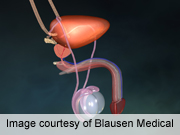
TUESDAY, April 17 (HealthDay News) — A new study raises questions about the value of proton therapy, an expensive new kind of radiation treatment, in patients with prostate cancer.
Those who received the treatment instead of the standard radiation therapy were more likely to suffer from gastrointestinal side effects, the researchers found. There also did not appear to be any extra benefit for those who got proton therapy.
Study co-author Dr. Ronald Chen, an assistant professor of radiation oncology at the University of North Carolina at Chapel Hill, didn’t go as far as to say proton therapy is a waste of money. But he did suggest that more research needs to be done to confirm its value.
“The bottom-line message is: Let’s study more, let’s do a clinical trial,” Chen said. “Patients and physicians should be cautious about new therapies and look for research data before they switch to a newer treatment.”
A variety of radiation treatments have become available to prostate cancer patients in recent years.
Up until about 12 years ago, conformal radiation treatment was commonly used. It relied on pinpointed X-rays to kill the cancer in the prostate while trying to avoid harming nearby organs, said Dr. Louis Potters, chair of the department of radiation medicine at North Shore University Hospital in Manhasset, N.Y., and Long Island Jewish Medical Center in New Hyde Park.
Scientists then developed a more sophisticated therapy called intensity-modulated radiation therapy (IMRT) that aims to do an even better job of avoiding radiation exposure to organs that are near the prostate. As of 2008, 96 percent of patients who received one of the two treatments got the newer therapy; that’s a huge change from 2000, when hardly any received IMRT.
Meanwhile, proton therapy appeared on the scene. In proton therapy, physicians try to kill cancer with a radioactive particle.
Medical centers have built proton centers around the country — they cost about $150 million each, Chen said — and have tried to convince patients to undergo the therapy.
In the new study, researchers examined the medical records of nearly 13,000 men who received conformal radiation, IMRT or proton therapy for prostate cancer that hadn’t spread.
The investigators found that patients who received IMRT, compared to conformal therapy, were 9 percent less likely to have gastrointestinal side effects and 22 percent less likely to have the rare side effect of hip fracture; they were also 19 percent less likely to need more cancer treatment.
On the other hand, IMRT patients were 12 percent more likely to suffer from erectile dysfunction, the findings showed.
The design of the study didn’t allow the researchers to determine the specific likelihood that a patient would suffer from these side effects or need more treatment.
The researchers also compared IMRT to proton therapy. Those who received IMRT had a 34 percent lower risk of gastrointestinal side effects.
Proton therapy costs about $50,000 per patient, roughly twice as much as IMRT, study co-author Chen said.
But the new treatment does have its supporters. In a statement released Tuesday, Dr. Eugen Hug, medical director and chief medical officer of ProCure Treatment Centers, took issue with the findings. He said the UNC study “is firmly contradicted by a number of well-regarded, peer-reviewed studies that found protons reduce — not increase — gastrointestinal side effects.”
According to Hug, “the UNC study runs counter to what we know from these studies, from research being carried out by ProCure and other proton centers and from our firsthand experience treating hundreds of patients with this important cancer therapy.”
Hug also pointed to prior prospective studies (which follow patients over time) that he said support the superiority of proton therapy. “Prospective studies like these are in general considered ‘higher level’ evidence than retrospective studies like the UNC study,” he said.
Still, the new findings should make people think twice about proton therapy, said Potters, the New York radiation physician.
“Proton therapy is marketed as something that’s new, big and expensive. In the eyes of the public, it’s easy to become wowed by proton beams,” Potters said. “But it might not be better and may be adverse in terms of side effects.”
Chen put it this way: “There is a newer technology out there, but right now we don’t know that it is better.”
The study is published in the April 18 issue of the Journal of the American Medical Association.
More information
For more about prostate cancer, try the U.S. National Library of Medicine.

